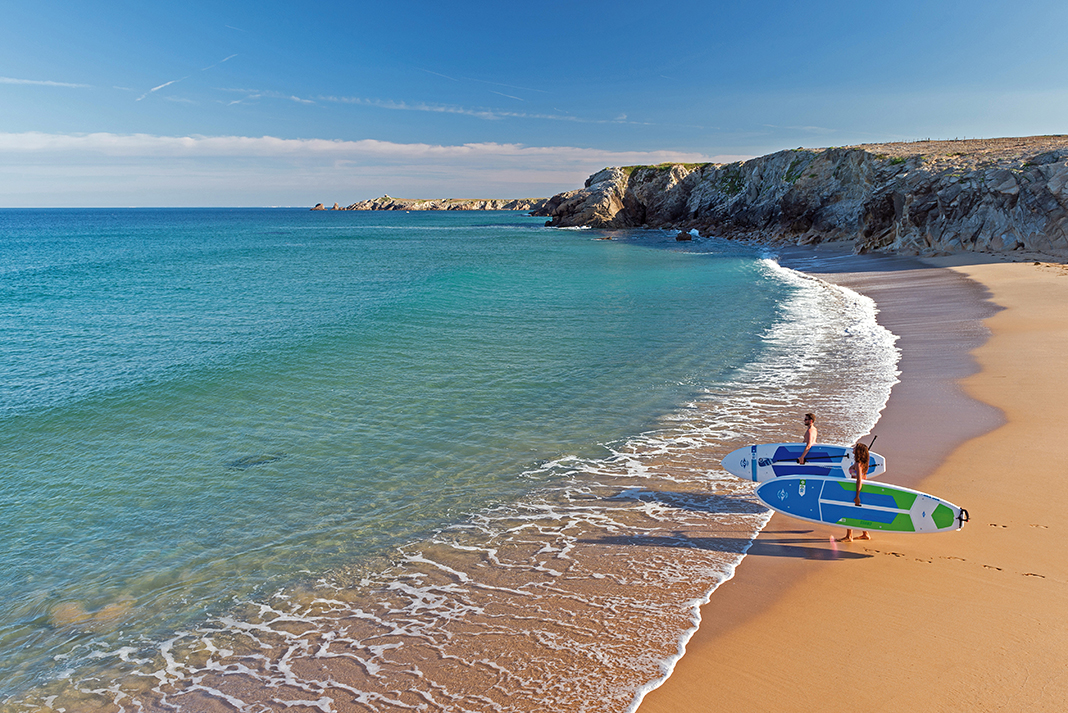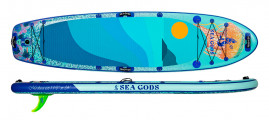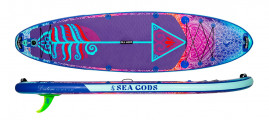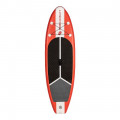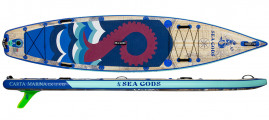Whether you’ve spent your life on the water or are just beginning to explore the blue spaces around you, jumping on a paddleboard provides a unique perspective, easy learning curve and a great workout. It’s also easy to get started; standup paddleboarding requires only a few pieces of equipment—just a board, paddle, personal flotation device (PFD) and ankle leash.
Paddleboarding is appealing for paddlers looking for a full-body workout, and for others who want to experience paddling without sitting or kneeling for extended periods as they would in a canoe or kayak. Also known as SUP, standup paddleboarding can be enjoyed anywhere there’s water to paddle, with board designs ranging from versatile all-rounders to specialized shapes for surfing, SUP yoga, touring, racing and even whitewater. Many anglers are also discovering the allure of fishing from a standup paddleboard.
The selection of standup paddleboards can seem overwhelming to a first-time shopper. Nearly all paddlesports and outdoor shops carry boards. Inexpensive, entry-level boards are also available from many big-box stores, as well as online marketplaces. For those who don’t have the space or means to store and transport a rigid SUP paddleboard, inflatable boards are a great option for unrivaled portability and compact storage. This comprehensive guide will help you choose the best standup paddleboard for your needs, and answer questions that arise when shopping for a board.
Top picks: Best paddleboards for 2024
The following paddleboards have received the highest star ratings by reviewers in our Paddling Buyer’s Guide. See and review all paddleboards here.
Best Paddleboards

Wayfarer
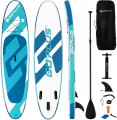
Inflatable SUP 11'
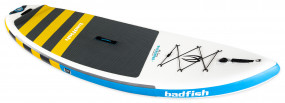
Rivershred
Shop best paddleboards
The first step in buying a paddleboard is understanding which type of board you are looking for. This is partially determined by the activities you hope to do, but also your skill level, budget and storage space. Use the links in this section to browse our Paddling Buyer’s Guide, where you’ll find every paddleboard available along with key information like specs, user reviews and where to buy quality boards from trusted brands.
Shop paddleboards by type
Fishing paddleboards
Motorized paddleboards
Hard paddleboards
Surf paddleboards
Beginner paddleboards
Pedal paddleboards
Modular paddleboards
Ocean paddleboards
Touring paddleboards
Clear paddleboards
Foldable paddleboards
River paddleboards
Racing paddleboards
All around paddleboards
Shop paddleboards by paddler/passenger
Shop paddleboards by size
Shop paddleboards by material
Shop paddleboards by price
Shop paddleboards by brand
Aquaglide paddleboards
Aqua Marina paddleboards
Bic paddleboards
Blu Wave paddleboards
Boardworks paddleboards
Body Glove paddleboards
BOTE paddleboards
Hobie paddleboards
Intex paddleboards
Jimmy Styks paddleboards
Lifetime paddleboards
Liquidlogic standup paddleboards
NRS paddleboards
Pau Hana paddleboards
Peak paddleboards
Pelican paddleboards
Perception paddleboards
Red paddleboards
Slingshot paddleboards
Sun Dolphin paddleboards
Tower paddleboards
Vibe paddleboards
Wavestorm paddleboards
Shop paddleboards by store
Best paddleboards
With so many SUP paddleboard options, use our picks of the most popular boards to begin your search. If you know what type of paddleboard you are looking for, then filtering by the brand is also helpful. Trust the companies with a longer history of making paddleboards to have better performing designs and reliable quality control measures in place.
Best paddleboards by type
- Best Kids Paddleboards For 2024
- Best Inflatable Paddleboards For 2024
- Best Pedal Paddleboards For 2024
- Best Motorized Paddleboards For 2024
- Best Surf Paddleboards For 2024
- Best Cheap Inflatable Paddleboards For 2024
- Best Touring Paddleboards For 2024
Best paddleboards by brand
- Best Jimmy Styks Paddleboards For 2024
- Best BIC Paddleboards For 2024
- Best Peak Paddleboards For 2024
- Best Tower Paddleboards For 2024
- Best Wavestorm Paddleboards For 2024
- Best BOTE Paddleboards For 2024
Shopping for a used paddleboard?
Certain things are essential to consider when looking for a used paddleboard. First and foremost, keep in mind that board design can vary a lot depending on the type of paddling for which the board is intended. Don’t cave to the pressure of buying a board that may be a good deal but isn’t the right fit. If you’re just starting out on your paddleboarding journey, or you want to do a bit of everything, a beginner all-rounder board is the best choice.
To help you better understand how to buy a paddleboard on the used market, heed the following advice:
1 Pick a design
Start simple: What do you want to do with the board? Paddleboards are generally divided into surf, all-around and touring categories. From there, some boards carve more specific niches, such as racing or yoga-specific paddling.
2 Consider materials
As a general rule with rigid paddleboards, the lighter the materials, the more expensive the board will be. Inflatables are the opposite—with more expensive boards having heavier-duty dual-construction layups, adding durability and outfitting options. The savings from buying used may mean you can upgrade to better materials while staying in the same budget range.
3 Know the brands
In the age of shipping direct from factories to consumers, unfamiliar brands that are available only online can appear in targeted advertisements. These companies may have nailed the search engine optimization, but they might lack the quality control that comes with companies with a longer track record of producing boards. We’re not saying don’t trust new companies, but do some thorough research from third-party reviewers before committing to a purchase.
4 Try before you buy
This is the absolute best way to know if the paddleboard you are looking at is right for you. Ideally, use the board in the conditions in which you would typically paddle. Demo sessions at symposiums or races are an excellent opportunity to test-paddle a variety of boards, and hopefully, as pandemic restrictions ease, more of these events are planned. If you are buying privately, ask to meet the seller at a location where you can try the board on the water. Bring a SUP paddle and a PFD (unless these are included with the sale), and wear the clothing you would normally paddle in.
5 Find a source
Events are a great way to meet people in the paddling community, and often local paddlesports shops or dealers are the hubs of these communities. Buying local also means you can talk to an experienced person who can answer any questions that may arise or address any issues you have. Should you upgrade your paddleboard down the road, they may take the board as a trade-in or help you find a buyer for it. Specialized online classifieds such as PaddleMonster.com are another great source for mid- to high-end used paddleboards.
6 Ask questions first
Find out how the previous owner used their paddleboard and see if it matches your intended paddling style. This may also be a good way to gauge how heavily the board was used. If any important information—like dimensions, material and condition—is missing from the ad description, ask for clarification before looking at the board.
7 Meet in person
This goes without saying. Unless you personally know the seller, shipping paddleboards is a costly and risky endeavor. It’s much better to physically see the board you are going to buy, and know you aren’t going to get scammed. Even with the supply of used paddleboards as limited as it is, the risk is not worth it.
8 Check for damage
Thoroughly inspect the board for dents, dings and signs of UV damage, such as fading or loss of luster from the board’s shiny surface. Minor scratches aren’t a big deal, but avoid any boards with cracks, punctures or deep gouges exposing the fiber weave (for composite boards). If you are inspecting an inflatable, blow the board up to its recommended PSI and examine the seams and valves, listening and feeling for air leaks. Seeing how/where the board was stored also helps to anticipate any other damage that may have occurred from UV or moisture.
9 Agree on price
Fair value of a used paddleboard may be difficult to gauge, but consider the level of use and condition the board is in when making an offer. Remember that a used board purchased from a private seller has no warranty, reason alone that new boards command a higher price.
For more tips when shopping for a used paddleboard, read our article How To Buy A Used Paddleboard.
Paddleboard buying guide
If you are wondering how to choose a standup paddleboard, you are in the right place. Remember, the most important factor in selecting the best paddleboard to suit your needs is deciding how and where you’ll use the board. Not all SUP paddleboards are created equal, and different boards do different things well. If you’re just starting out on your paddleboarding journey, or you want to do a bit of everything, a beginner all-rounder board is the best choice.
Don’t forget to leave room in your budget for other necessities when buying a paddleboard. You’ll also need a SUP paddle and two essential safety items: a properly fitting PFD (personal flotation device) and ankle leash. Getting the best quality paddle you can afford is arguably just as important as a good board. A lightweight, comfortable paddle plays a far bigger role in how much you’ll enjoy your paddleboarding experience than a slightly lighter or flashier board.
Discover the different styles and purposes of paddleboards in Buying a SUP: The Ultimate Guide. For a deep-dive into paddleboard design, construction, materials, weight, dimensions, price and more, find the answers to all your questions below. These will help you better understand how to pick a paddleboard that matches your needs.
-
What does SUP stand for paddleboard?
SUP stands for “standup paddleboard”. These boards are paddled with a long, single-bladed paddle from a standing position. Inflatable paddleboards are sometimes referred to as iSUPs, and the “i” at the front of a board’s name is a good indicator it is an inflatable.
-
What is SUP paddleboard?
At first glance, a SUP board looks much like a large surfboard, but there are some key differences. A paddleboard is wider and thicker than a traditional surfboard so the paddler can balance easier while standing. Paddleboards can be used on all types of water, while a surfboard is designed expressly for catching and surfing waves. Many different paddleboard designs are available, with boards catered to touring, surfing, yoga, fishing or all-around paddling.
-
Is a paddleboard a boat?
This is a trickier question to answer than you might think. In most circumstances, a paddleboard is considered a boat (or vessel) in the eyes of the law. In Canada and the United States, Coast Guard regulations treat paddleboards the same as kayaks and canoes. This means that paddlers are required to wear a personal flotation device (PFD) and have a sound-signaling device with them (i.e., a whistle). If paddling after sunset or before sunrise, a water-tight flashlight or headlamp is also required. The only exemptions to these regulations are if the paddleboard is used for “non-navigational” activities, such as using the board within a designated swim area, or for SUP yoga or surfing.
-
Paddleboard vs kayak
Should you buy a paddleboard or a kayak? This can be a tough question, but considering the differences may help you decide. A primary difference is the paddler’s perspective. Paddleboarders stand above the water (although they can sit or kneel as well) while kayakers are seated at water level. Read more about how stability, speed and exercise differ when comparing Paddleboard vs. Kayak.
-
How are paddleboards made?
Paddleboard manufacturing methods can vary depending on the materials used. One of the most common methods is the same process used to make surfboards, in which a foam core is encased with epoxy and fiberglass or other high-strength materials.
Thermoforming is another common paddleboard manufacturing process. To create a thermoformed board, plastic sheets are heated and then shaped over a mold. This process is used on both low- and high-end boards, and the materials and manufacturer play a critical role in the end quality of the board.
Inflatable paddleboards are constructed with PVC using a technique called drop-stitching. Thousands of tiny fibers are sewn between two pieces of PVC material, enabling this flexible material to maintain a durable, rigid shape once inflated. Drop-stitching creates a flat, rigid shape, so these inflatable paddleboards can rival hardboards for efficient paddling performance.
-
Types of paddleboards
At the most simplistic level, paddleboards are designed for one of three purposes: surf, recreation or touring and racing. In other words: playing on waves, hanging out and having fun on the water, or hustling from A to B. What you want to do on the water determines the right board style for you.
The all-around board or recreational SUP is the most popular category on the market. It blends characteristics from both surf and touring designs. All-around boards are built like a surfboard but longer, thicker and wider, between nine and 11.5 feet long and over 30 inches wide. Like a surfboard, they have planing hulls—flat bottoms that curve up at the nose (front) to skim across the water, rather than slice through it, for easier turning and wave-riding.
Niche categories of all-around boards have become more common as the sport develops and have specialized characteristics of their own. These include extra-stable yoga SUPs with generously cushioned decks for comfort; fishing-specific boards with lots of tie-down points for gear, attachment points for rod holders and extra width to provide a stable platform; and whitewater paddleboards, most of which use durable inflatable construction to bounce off rocks without damage.
Surf SUPs are narrower and shorter, about 10 feet or less, than all-around boards for quick responsiveness and maneuverability. While nimble on a wave, on flatwater you’ll likely find these boards slow and unstable.
Racing and touring paddleboards are for going places—either extended day trips, overnight expeditions or as fast as possible on race courses. What boards in this category all have in common is their greater length, usually 12 feet or more, and displacement hulls with V-shaped bottoms and pointed noses for cutting through the water more efficiently.
Check out Types Of Paddleboards for an in-depth look at each category.
-
Paddleboard dimensions
How long is a paddleboard? The length of your board will largely be decided for you by how you’re planning to use it and how big you are. Generally, surf SUPs are nine feet or shorter to allow for easier turns, recreational all-around paddleboards are 10 to 12 feet, and touring SUPs are 12 feet and up for enhanced speed and glide.
Narrow down the model of board based on how you’re going to use it and then fine-tune the length based on your size. For example, the same all-around board may be available in a 10’6” or an 11’6” length, with the longer one designed for riders over 200 pounds.
Generally, wider boards will be more stable. Wider boards suit less experienced riders and activities that favor stability over speed, like fishing, yoga, all-around recreational use and learning to surf. Wide boards also suit larger riders. Most recreational and beginner boards are 28 to 36 inches wide.
How thick is a paddleboard? Paddleboard thickness relates to volume, with a thicker board having a higher volume and more buoyancy and stability. In general, beginner boards will be thicker than boards aimed at intermediate and advanced paddlers. Many manufacturers also offer a range of sizes with varying thicknesses that correspond to different rider weights. This is because taller and heavier paddlers will need a higher volume board for float and stability. Touring and racing boards may have thick rails and a thin deck, so the paddler stands lower on the board, increasing stability. Materials can also play a role in paddleboard thickness; inflatable boards are thicker due to their blow-up construction.
-
How much does a paddleboard weigh?
Paddleboard weight varies greatly depending on dimensions, material and outfitting of the board. The lightest paddleboards weigh around 15 pounds, while heavier ones weigh over 40 pounds.
-
How much weight can a paddleboard hold?
Paddleboard weight limit varies depending on the board and can usually be found in the “specs” listed by the manufacturer. Board volume—often expressed in liters, and calculated by multiplying the length x width x thickness—is a good indicator of weight limit. Higher volume paddleboards have higher weight limits. The buoyancy and strength of the materials also plays a part in a paddleboard’s weight limit to some degree. For specific information about how much weight a paddleboard can hold, consult the manufacturer’s website or the Paddling Buyer’s Guide.
-
What size paddleboard should I get?
The ideal size of paddleboard will be determined by the type of paddling you want to do, and your body size. After first settling on the type of SUP (surf, all-around or racing/touring), the size of the board relates to the paddler’s size. If a specific board model is available in multiple sizes, the brand will provide a sizing guide. Taller and heavier paddlers will want a higher volume board for buoyancy, while smaller paddlers can paddle a lower volume board. Board length is more dependent on activity, and a shorter board does not always suit shorter paddlers. Learn why this is the case, and find more board sizing tips, in our article What Size Paddleboard?
-
What are paddleboards made of?
Paddleboards are made from a variety of materials. The most common materials for rigid boards are fiberglass and epoxy or other composites. Most entry-level boards use plastics, often through thermoforming processes. Others are made with bamboo or other wood combinations. Inflatable paddleboards are made with flexible synthetic materials like PVC. For paddler comfort, most paddleboards are equipped with a foam pad area to stand on.
-
Why are paddleboards so expensive?
Although a paddleboard may just seem like a slab of material that you stand on, a lot of design and engineering has gone towards making a board that is fun and easy to paddle. Quality boards come at a higher price, but they also perform better and will last longer. Higher cost boards often come with significant reductions in weight and more functional outfitting. The saying, “You get what you pay for”, rings true and spending a bit more money upfront results in a high-performing board.
-
Why are paddleboards more expensive than kayaks?
Paddleboards made with high-quality materials are more expensive than entry-level kayaks. Entry-level boats and boards generally cost the same, but the pandemic paddlesports boom has also changed the prices. Increased demand for paddleboards and recreational kayaks has raised prices significantly, and in some places, paddleboards may be in even greater demand than kayaks.
-
How much are paddleboards?
Depending on their design, the materials used and the brand producing them, paddleboards can range from $400 to upwards of $2,000. With patience and a keen eye, buying used can help to maximize your dollar value. We break down the costs of different boards and brands in our article How Much Are Paddleboards?
-
When do paddleboards go on sale?
Paddleboards, like most paddlesports equipment, go on sale in the shoulder seasons, fall and spring. At the end of the summer, shops may be looking to clear out their stock to make room for next year’s deals. Before the paddling season, used paddleboards are easier to find as people upgrade their current setups or clear out their garages.
-
How long do paddleboards last?
A paddleboard that is properly cared for will last many years. It is essential to store the board properly: this includes away from direct sunlight and moisture. Storing the paddleboard indoors is the ideal location, but outdoors on a shaded rack works as well. It is tempting to wrap the board in a tarp in the winter, but this may trap moisture inside. It is better to have a tarp spread above the board with space for airflow.
Always rinse and fully dry inflatable paddleboards before packing them away. Inflatable boards should not be stored in their duffel for too long; ideally, once a month, pull the board out and repack it. This prevents creasing that can lead to weakness over time.
-
What is a hybrid paddleboard?
A hybrid paddleboard is a board designed to be paddled standing or sitting—think of it as a kayak/paddleboard combo. These are good crafts for those who want versatility and may not be comfortable standing the entire time they are out paddling. Hybrid paddleboards are especially ideal for fishing; with chair mounting options, the angler can both sit or stand. As hybrids borrow aspects of both kayaks and paddleboards, don’t expect them to ‘”do it all” perfectly, but instead consider them a compromise of both.
-
What is a soft standup paddleboard?
The most common type of soft standup paddleboard is a “soft-top”, which refers to the foam construction of the board. These entry-level boards are great for learning and casual use. The foam is comfortable to stand on and, more importantly, forgiving to fall on. Some may also call inflatable paddleboards “soft” paddleboards. Inflatables offer exceptional portability and easy storage along with a more forgiving, cushiony deck than a rigid board.
-
Do all paddleboards have fins?
Fins are an essential component of a paddleboard to help it move in a straight line, also known as tracking. Paddleboard fins come in different styles, with a single fin or tri-fin—a deep center fin with two smaller “thruster” fins—being the most common configurations. Thruster setups are mostly found on river and surf paddleboards, as well as some all-around boards, while a single fin is the standard on touring boards.
-
Where to buy paddleboards
You can buy paddleboards anywhere paddling equipment is sold. Dedicated paddlesports outfitters and outdoor stores such as MEC and REI sell boards, leashes, PFDs and other essential items. Knowledgeable staff are also able to answer any questions that you may have, and help you find the best paddleboard for your needs.
Paddleboards can also be bought at big-box stores and through online retailers like Amazon. These are typically entry-level boards suited for beginners and casual recreational use.
Used paddleboards are found through online classifieds like Craigslist or Kijiji. Specialized paddling classifieds like PaddleMonster.com are a great place to find higher-end racing and touring boards. As pandemic restrictions ease, SUP races and events will hopefully make a resurgence. At these events, dealers often bring boards for people to try, and the demo boards are often for sale at great prices.
Our Paddling Buyer’s Guide features nearly every paddleboard on the market, with information on where to buy that specific board.
Paddleboard reviews
Begin your search by reading paddleboard reviews in the Paddling Buyer’s Guide. Reviews can be a useful tool to help find the best standup paddleboard for your needs. You’ll get a sense of where each paddleboard excels or where it may not. See if the type of paddling the reviewers do matches your style and if the board matches your budget.
- Inflatable Paddleboard Review: ISLE Pioneer 2.0
- Inflatable SUP Review: BOTE Rackham Aero 12’4”
- Inflatable Hybrid Review: TAHE Beach SUP-YAK
- Hybrid SUP Kayak Review: Hobie Mirage Lynx
- Hybrid Fishing SUP Review: Vibe Cubera 120
- Inflatable Paddleboard Review: Red Paddle Co 11’3” Sport
- Hobie Mirage i11S Inflatable Kayak-Paddleboard Hybrid Review
- Vibe Kayaks Premiers Maverick 120 SUP At ICAST 2018
- Hobie Mirage Eclipse SUP Board (Video)
- Video: C4 Waterman’s 2017 Pono SUP Board



